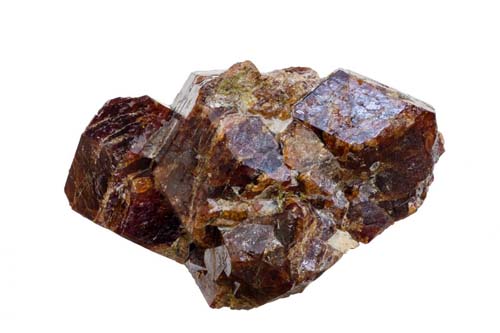Type
Mineral
Mineral Classification
Silicate
Chemical Formula
X3Y2(SiO4)3 (Where X is often Ca or Mg, and Y is often Al or Fe)
Streak
White
Mohs Hardness
6.5-7.5


Type
Mineral
Mineral Classification
Silicate
Chemical Formula
X3Y2(SiO4)3 (Where X is often Ca or Mg, and Y is often Al or Fe)
Streak
White
Mohs Hardness
6.5-7.5
Crystal System
Isometric (meaning equality in dimension. For example, a cube, octahedron, or dodecahedron)
Color
Generally brown, virtually all colors, blue very rare
Luster
Vitreous, resinous
Fracture
Conchoidal, uneven
Garnet is usually thought of as a gemstone but most garnet is mined for industrial uses. A very small number of garnets are pure and flawless enough to be cut as gemstones. The majority of garnet mining is for massive garnet that is crushed and used to make abrasives. Garnet is a silicate mineral group; in other words, garnet’s complex chemical formula includes the silicate molecule (SiO4). The different varieties of garnet have different metal ions, such as iron, aluminum, magnesium and chromium. Some varieties also have calcium.
Mining methods for the extraction of garnet vary depending on the geologic environments responsible for the host rock. At hard-rock locations, such as the Barton mine in northern New York, open-pit methods have been employed for decades. In China, hard-rock mining may consist of more primitive methods including hand mining.
Garnets are extracted and processed more easily from alluvial deposits. For example, at the Emerald Creek mine in Idaho, garnet is recovered from stream gravels from slots cut by backhoes or small draglines. These gravels are passed through a trammel to reject the oversize, and garnet is concentrated on large wet-jigging tables. The garnet is then shipped to the mill for final processing and packaging.
Beach deposits, such as those mined in Western Australia and in southern India, lend themselves to low-cost earth-moving techniques using scrapers and bulldozers to cut and excavate benches parallel to the trend of the beach and/or bar deposit. Because manual labor remains central to the operator’s community responsibility in India, mechanized mining provides only a portion of the mining activity there.
In general, processing involves the separation of the heavier garnet from lighter gangue minerals and the further separation of garnet into discrete size classes designed to meet the needs of specific markets. Following crushing (which is determined by the nature of the specific deposit or the market served), ores typically are washed to segregate material by specific gravity. Most operators employ traditional spiral classifiers for this step, some in conjunction with hydrosizers. At least one company uses flotation methods for the separation of garnet from heavy nonmagnetic fractions. Concentrates are dried and then sorted by both high-intensity magnetic and electrostatic separators.
One producer that markets very fine grades for precision grinding and polishing markets also rely on wet-separation techniques for quality control. Final separation yields a product exceeding 95% garnet minerals, which usually contains less than 0.5% quartz by weight. The final production step is dry screening and classifying into marketable sizes, then packaging for sales and distribution.
Garnet is ground to a variety of sizes to be used as an abrasive. Garnet sandpaper was the original application of this mineral. It is also used to make a number of similar products, including sanding belts, discs, and strips. Today, the vast majority of garnet is used as an abrasive blasting material, for water filtration, in a process called water jet cutting, and to make abrasive powders.
If you have some questions about our products, please feel free to fill out the form below, and we will contact you within 24 hours. Rest assured that we won’t reveal your information to anyone.